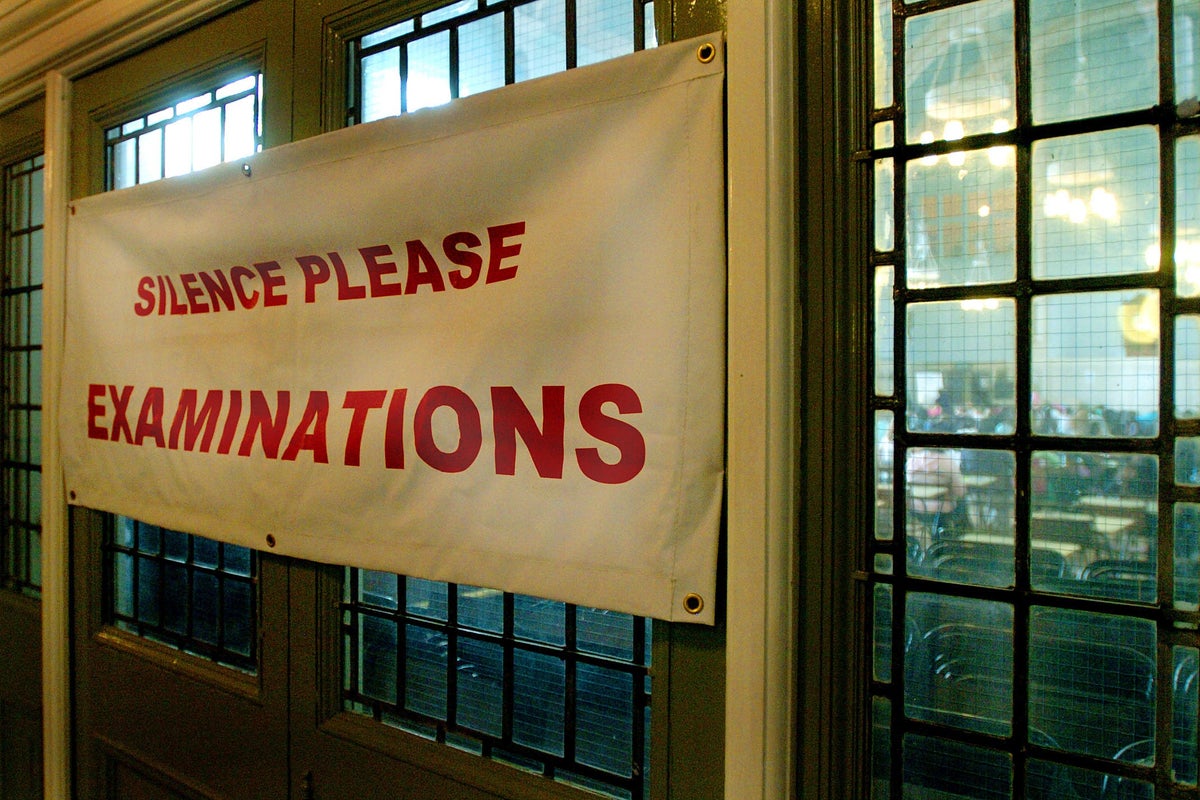
London and south-east England have seen larger year-on-year falls in the GCSE pass rate than all other regions, the 2025 exam figures show.
Some 71.6% of entries in London were awarded grade 4 or above this year, which is considered a standard pass.
This is the highest for any region in England, but down nearly a full percentage point from 72.5% in 2024.
In south-east England the proportion has dropped from 70.4% to 70.0%.
Most regions have seen a drop in the standard pass rate this year, though by a smaller margin.
For example, in the West Midlands the figure has fallen from 63.1% to 62.9%, the lowest for any region in England, while neighbouring East Midlands is down by just 0.1 percentage points from 65.1% to 65.0%.
Only one region saw a clear year on year increase in entries receiving a grade 4 or above: eastern England, up from 67.9% to 68.0%.
Four regions saw a greater proportion of entries awarded 4 or above than in the pre-pandemic year of 2019: eastern England, north-east England, London and south-west England.
London is also the region with the highest proportion of entries awarded the top grades of 7 or above, at 28.4%, down slightly from 28.5% in 2024.
North-east England had the lowest regional percentage at 17.8%, unchanged from last year.
These regions have recorded the highest and lowest proportion of entries getting the top grades in each of the past three years, but the gap between them has narrowed over that period, from 10.8 percentage points in 2023 to 10.7 points in 2024 and 10.6 this year.
The gap remains wider than before the Covid-19 pandemic, however, when it stood at 9.3 points in 2019.
It is also wider than at any point in the pre-pandemic period back to at least 2009, when the earliest archive data is available, according to analysis by the PA news agency.
London is one of three regions to see a year-on-year drop in entries receiving top grades, along with south-east England (down from 24.7% to 24.6%) and the East Midlands (from 18.3% to 18.1%).
The East Midlands is the only region where the proportion of entries awarded 7 or above this year, 18.1%, is lower than the equivalent figure in the pre-pandemic year of 2019 (18.3%).
At a national level, 31.6% of entries in Northern Ireland received grade 7/A or higher, above the equivalent figure for England (21.8%) and Wales (19.5%).
For entries awarded 4/C or higher, Northern Ireland was ahead at 83.5%, some way above England (67.1%) and Wales (62.5%).
Here are the percentages of GCSE entries awarded the top grades of 7 or higher, by nation and region, in 2025, with the equivalent figures for 2024 and the pre-pandemic year of 2019:
– North-east England 17.8% (2024: 17.8%; 2019: 16.4%)– North-west England 18.8% (2024: 18.6%; 2019: 18.6%)– Yorkshire & the Humber 18.4% (2024: 18.3%; 2019: 17.8%)– West Midlands 18.5% (2024: 18.5%; 2019: 18.1%)– East Midlands 18.1% (2024: 18.3%; 2019: 18.3%)– Eastern England 22.2% (2024: 21.4%; 2019: 20.5%)– South-west England 21.4% (2024: 21.2%; 2019: 20.4%)– South-east England 24.6% (2024: 24.7%; 2019: 23.5%)– London 28.4% (2024: 28.5%; 2019: 25.7%)– England 21.8% (2024: 21.7%; 2019: 20.7%)– Wales 19.5% (2024: 19.2%; 2019: 18.4%)– Northern Ireland 31.6% (2024: 31.0%; 2019: 30.5%)– All 21.9% (2024: 21.8%; 2019: 20.8%)
Here are the percentages of GCSE entries awarded 4 or higher, by nation and region:
– North-east England 64.9% (2024: 65.2%; 2019: 63.8%)– North-west England 64.2% (2024: 64.2%; 2019: 64.9%)– Yorkshire & the Humber 63.6% (2024: 63.9%; 2019: 64.1%)– West Midlands 62.9% (2024: 63.1%; 2019: 63.8%)– East Midlands 65.0% (2024: 65.1%; 2019: 65.8%)– Eastern England 68.0% (2024: 67.9%; 2019: 67.1%)– South-west England 69.1% (2024: 69.1%; 2019: 68.3%)– South-east England 70.0% (2024: 70.4%; 2019: 70.2%)– London 71.6% (2024: 72.5%; 2019: 70.6%)– England 67.1% (2024: 67.4%; 2019: 67.1%)– Wales 62.5% (2024: 62.2%; 2019: 62.8%)– Northern Ireland 83.5% (2024: 82.7%; 2019: 82.2%)– All 67.4% (2024: 67.6%; 2019: 67.3%)
